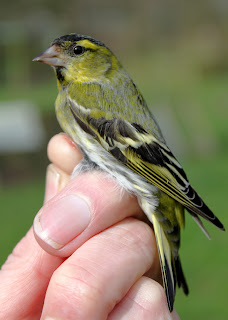We just seem to carry on catching finches in Will’s garden. Today we passed 75 new Goldfinch for the year, with during that period a handful only of retraps which shows a continuous and consistent passage of birds through February, March and to date in April, with perhaps today a hint of them tailing off.
Total of new birds caught this morning: Coal Tit 2, Goldfinch 7, Chaffinch 4, Lesser Redpoll 1, Siskin 1, Collared Dove 2, Robin 2 and Great Tit 1.
Retraps came in at one each of Goldfinch, Chaffinch, Nuthatch, Greenfinch, Great Tit , Blue Tit and Dunnock.

Lesser Redpoll

Lesser Redpoll

Siskin

Goldfinch

Nuthatch

Coal Tit

Collared Dove
The Nuthatch were busy in and out of their tree hole this morning and remained undeterred from their activities when we caught the already ringed male which returned to its labours immediately after release. Likewise busy in nest boxes in the garden were Jackdaw and Coal Tit.
Other birds seen today: Buzzard, Stock Dove 2, Lapwing 4, Swallow 4, already busy in and out of the outbuildings, Grey Wagtail 2 and Grey Heron 3.
It was an enjoyable session that started deliberately late at 0800 on the assumption that tomorrow will be the early 0600 start if that high pressure holds. Watch this space.
Total of new birds caught this morning: Coal Tit 2, Goldfinch 7, Chaffinch 4, Lesser Redpoll 1, Siskin 1, Collared Dove 2, Robin 2 and Great Tit 1.
Retraps came in at one each of Goldfinch, Chaffinch, Nuthatch, Greenfinch, Great Tit , Blue Tit and Dunnock.







The Nuthatch were busy in and out of their tree hole this morning and remained undeterred from their activities when we caught the already ringed male which returned to its labours immediately after release. Likewise busy in nest boxes in the garden were Jackdaw and Coal Tit.
Other birds seen today: Buzzard, Stock Dove 2, Lapwing 4, Swallow 4, already busy in and out of the outbuildings, Grey Wagtail 2 and Grey Heron 3.
It was an enjoyable session that started deliberately late at 0800 on the assumption that tomorrow will be the early 0600 start if that high pressure holds. Watch this space.





























































